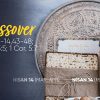What happened in Kiriath Jearim that proved that David was a man after God’s own heart?
We’re going to continue our study of the faith of King David, trying to understand how he who was an adulterer and murderer could be described in the Bible as a man after God’s own heart. We will continue looking at three examples from King David’s life which demonstrate that he did indeed have a deep relationship with God.
David’s exceptional relationship with the Lord was also often manifested in another way — through worship.
About seven miles west of Jerusalem there’s an Arab town called Abu Gosh. In biblical times it was a Jewish town named Kiriath Jearim. Today, believe it or not, the village of Abu Gosh is best known as the site of the Elvis Presley service station. It features two bigger than life statues of Elvis. The interior walls are plastered with Elvis album covers, and Elvis music plays 24 hours a day.
Across the street from the station is the “Hollywood of Israel” where Israeli movies are made in huge sound studios. Behind the movie lot is the location of a lovely moshav called Yad Hashmona. A moshav is a collective village like a kibbutz, but the difference is that at a moshav people own their own houses. The moshav, which looks like an Alpine village, was built with lumber supplied by Christians in Finland. The moshav is occupied by Messianic Jews who make their living by building furniture.
Up a hill from the moshav and adjacent to the movie studios is a French Catholic Church called the Church of the Ark of the Covenant. The steeple of the church features a statue of Mary holding the Christ child while standing on the Ark of the Covenant. It is symbolic of the fact that Jesus was the fulfillment of the prophetic significance of the Ark.
Everything about the Ark of the Covenant was prophetically symbolic of the Messiah. The Ark was made of wood, which was a symbol of the fact that the Messiah would be human. It was overlaid with gold, which was a symbol of the fact that the Messiah would be also divine.
Inside the Ark were three items: one was a pot of manna, another was the tablets of Moses that the Ten Commandments were written on, and a third was Aaron’s rod that budded. Each one of these had prophetic significance. Take for example the pot of manna. It was symbolic of the fact that the Messiah would be the Bread of Life. Then there was Aaron’s rod that budded, which was symbolic of the fact that the Messiah would die and come back to life, just as that rod did. And, the third thing was the tablets of Moses which were an indication that the Messiah would perfectly obey the Law of God and fulfill it in every respect.
On top of the Ark of the Covenant was a lid that was called the Mercy Seat. On each end there was an angel and their wings touched over it. Once a year the high priest would walk in and he would sprinkle blood on the Mercy Seat. This was a prophetic symbol for when the Messiah died that the spilling of His blood would make it possible for all of us to be reconciled to God, because the spilling of that blood would make it possible for the mercy of God to cover the Law of God.
The church marks the spot where the Ark of the Covenant was stored in a farm house for almost 70 years.
The very first time that I ever visited the Church of the Ark of the Covenant I had a startling experience. I’d like to tell you about it.
I had a pilgrimage group with me, and when I finished my lecture about the site, one of the pilgrims requested that we sing the song, “We Are Standing on Holy Ground.” So, we stood and started singing that song. The second phrase of that song is, “And I know that there are angels all around.” Just as we began to sing that, I lifted my hands, looked up at the ceiling, and lo and behold there were angels all over the ceiling!
Journey of the Ark of the Covenant
Let’s review for a moment how the Ark of the Covenant came to rest in the farm house of a man named Abinadab.
During the period of the Judges, the Children of Israel became increasingly rebellious toward the Lord. Near the end of that 400 year period of time, the Philistines sent an army against Israel. Incredibly, the Israelites decided to take the Ark of the Covenant out of the Holy of Holies and carry it into the battle with them. They believed that if they did that, God would not allow the Philistines to win. In short, the Israelites treated the Holy Ark like it was a rabbit’s foot that would bring them good luck.
Needless to say, the Lord was outraged over this desecration of the Ark and the fact that the Israelites were putting their faith in an idol rather than in God. In the ensuing Battle of Ebenezer, the Philistines routed the Israelites. They captured the Ark and then they proceeded to Shiloh where they destroyed the Tabernacle of Moses. Thus began the strange odyssey of the Ark.
The Philistines took the Ark to their capital of Ashdod where they put it in the temple of their fish god, Dagon. But, each morning, they found the statue of their god lying face down on the ground. Then, people began to experience a plague of tumors. That’s when the Philistines decided the Ark was a hot box they needed to get rid of. They sent it first to Gath, then on to Ekron, but both towns suffered calamities. Finally, they decided to put it on an ox cart and just head it back toward Israel. The ox cart wandered from town to town until it finally ended up right in Kiriath Jearim, where the Ark was stored in the farm house of Abinadab.
The book of First Samuel says the Ark stayed in the house of Abinadab for 20 years, but that must be a reference to the last 20 years that Samuel served as a judge of Israel. I say that because we know it continued to remain there during the 40 years of Saul’s reign and during the first seven years of David’s reign. So, it was there a total of 67 years!
The amazing thing is that the Tabernacle of Moses had been rebuilt in Gibeon, which is only two or three miles from there, yet no one cared enough to come get the Ark and return it to the Holy of Holies. The forgotten Ark became a symbol of Israel’s apostasy.
But, David had never forgotten it. And after he became king of all of Israel, which is seven years after he had been crowned King of Judah, he decided that the first priority of his kingship would be to bring the Ark to Jerusalem as a symbol of his determination to bring God back into the heart of his nation. According to Psalm 132, David took an oath that he would not sleep indoors or on a bed until the Ark of the Covenant had been returned to its proper resting place. David’s top priority as the king of all of Israel was to lead the nation into a spiritual revival with their God. And so, David came to Kiriath Jearim.
The priests put the Ark on their shoulders and they headed toward Jerusalem. David, in his delight, took off his outer priestly robe, and he began to dance before the Ark. He skipped and he shouted, he clapped his hands, he turned in circles. He began to shout “Hallelu et Adonai! Hallelu et Adonai!”
I’m sure that some who were viewing this were saying to themselves, “This guy is making an absolute fool out of himself!” Well, that’s exactly what David’s wife, Michal, thought when she saw him dancing before the Ark as he entered Jerusalem. She was mortified by his unkingly behavior, and she told him so in no uncertain terms when he got home. I love David’s reply. He said to her, “Honey, you ain’t seen nothing yet!” In short, he was more than willing to be a fool for the Lord’s sake.
The story ends with a sobering thought. We are told that because of her criticism of David’s worship, Michal’s womb was struck barren by God. The message is that God takes worship very seriously, and we had better be very cautious about criticizing anyone’s worship.
And so you have it, David in Kiriath Jearim is yet another example of David’s incredible dedication to God.
The in the fourth and part of this study of the faith of King David, we will look at the third of three examples from King David’s life which demonstrate that he had a deep relationship with God.









